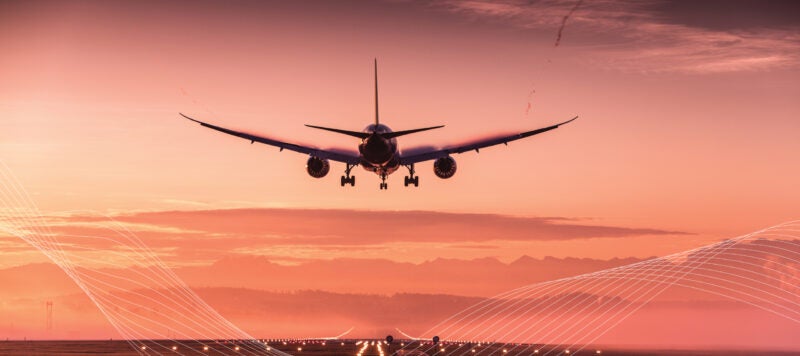Latest News
ST Engineering iDirect and its partners are hosting a series of webinars focused on advanced mobility technology and its impact and importance to end user customers. As part of that series, ST Engineering iDirect sponsored the following article to gather perspectives of end users on the importance of satellite connectivity for the mobility market.
Our world relies on all sorts of fleets – aircraft, ships, automobiles, rail cars, tractors – to navigate our daily lives. Travel for recreation and business, shipping and the global supply chain, and moving raw materials for fuel and production, are just a few of the activities that must keep pace with our fast-moving society. Our insatiable appetite for connectivity wherever we go, on land, sea or in the air has driven up our expectations and is spurring operators of aircraft, vessels, trains and vehicles to consider satellite as an access technology, offering connectivity across networks, right to the very edge. Mobile users have become one of the primary use cases for satellite communications, given their often-remote location, disadvantaged status and movement across land, water or air. Broadband has become as essential to businesses as electricity or water is. As with those utilities, there are extra steps involved in supplying broadband to mobile fleets. Additionally, technology is changing rapidly in space, in the cloud and on the ground, making for a proverbial moving target as well as a literal one.
Each user has their own unique set of requirements and therefore it’s critical that those are understood by the satellite industry, so that it can deliver the service that’s needed. So, what are service providers and users looking for?
Maritime
NSR predicts bandwidth demand will increase rapidly in this sector with more than 950 Gbps of FSS and HTS capacity forecasted by 2030. It expects the market to grow to more than 142,000 broadband vessels by 2030 with a yield of close to $35 billion in cumulative retail revenues.
Shipping companies are very dependent on satellite communications to connect their remotely located mobile businesses, improving efficiency and performance. They have a very keen interest in how new satellite technology and innovation can help lead to overall improvements in their businesses. New constellations, new waveforms, terminal form factors, and a new 5G world to connect will benefit these businesses. However, this also comes with many more factors to consider. It is clear that these companies will need more bandwidth as their businesses become more data intensive.
Fugro is a geo-data specialist, collecting and analyzing information to unlock insights to help its clients design, build and operate their assets in a sustainable and efficient manner. This is especially effective in areas such as oil & gas and maritime by leveraging satellite connectivity to benefit its clients. Four years ago, Fugro decided to put satellite front and center of its communications strategy.
Oigen Blankert, Manager Marine IT Operations and Support for Fugro, said, “Connectivity is key to running our business” and this attracts “a lot of attention” from people working within the company. He points to a shift in Fugro’s attitude that happened about three years ago when they realized they needed more capacity because of their remote operations, due to having fewer people on the vessels, and lower operational costs.
Kris Vedat is the Head of Information Technology at P&O Maritime Logistics, which uses satellite for its operational systems. Vedat cares about the cost and the scalability of satellite communications. He says that cost is always going to be a pain point for companies like P&O. “We certainly work in lean times in the offshore industry,” he says. Vedat points to flexibility as key to meeting client demands and expectations. Depending on what satellite operator you are working with, some can be very flexible bandwidth-wise. Others are not so flexible.”
As a customer, Vedat thinks the satellite industry can be reluctant to allow new technologies and players into its ecosystem at times. “We as a client have to push this,” he says. “In today’s environment, communication needs to be hybrid. We are only now touching 5G on the vessels and the automatic fall over between VSAT and 5G. Very few operators have been willing to do that. If you can use 5G technology 40 miles from the shore, you are not going to have upscaled VSAT communications,”

Many within the ground segment side of the satellite industry would agree. Sean Yarborough, Vice President Product Management at ST Engineering iDirect said, “The future of connectivity will be hybrid. There’s not one access technology that fits all. Satellite might be the most suitable option for the more remote aspects of a journey. But in more populated, better-connected regions, it might be microwave or cellular. It’s all about creating a connectivity landscape that offers the right technology for the right application at the right time – and that means having the capability to provide hybrid connectivity.”
Blankert says the number one thing that Fugro would like to achieve is a faster, lower latency service and he believes NGSO constellations could have a big impact. Blankert says that Fugro is interested in testing on new constellations to see what the quality of service is like and what the technological limitations are. Like Blankert, Vedat thinks the demand for increased bandwidth is inevitable and that NGSO could step into the breach.
Satellite operator Eutelsat unveiled its new managed service, Eutelsat ADVANCE, last year. Pierre-Jean Beylier is Head of Connectivity at Eutelsat. He says, “ADVANCE can provide powerful, extensive coverage for maritime services around the world by offering total flexibility on industrial bandwidth requirements while providing guaranteed performance, a customized service and SLAs. The innovative network solution relies on the Newtec Dialog® platform and its game-changing Mx-DMA® waveform to enable greater two-way communications links, and higher throughput.”
Just recently, the ADVANCE network demonstrated reduced latency for some offshore vessels. Beylier comments, “One of our service providers has experienced a significant reduction of latency in the network. Mx-DMA enables higher throughput per given watt of antenna power, allowing our service provider’s demanding offshore customer to run voice calls and video more smoothly, as well as operational apps that are latency sensitive such as real-time monitoring of well flows, fuel consumption and more, leading to increased SLA performance.” Beylier continues, “Today we are offering a path to lower latency on our GEO network. This is a true win-win because it is the best of today while we make way for the best of tomorrow.”
There will now be heightened expectations on satellite companies to deliver. Companies like Fugro and P&O are trying to evolve their business and operating models and make them more efficient. This can involve remote diagnostics. Vedat says the satellite community needs to accept that the demand on them is going to be higher.
“I think the expectation [is] going to be higher. It is known that VSAT communication is reliable to a certain extent. You have line of sight issues, degradation of service issues, and more. I don’t think people will accept that anymore. The technology that is coming out needs to have a far greater uptime and availability capacity than it does today. The expectation now is that the communications out at sea should just be as good as landside. I know realistically, that is not quite possible, but that is the expectation people and crew have now,” Vedat says.
“We have been taking IoT data from the equipment and using that to enhance our predictive and condition maintenance plans,” says Vedat. By diversifying its operating model and taking a logistics driven mindset in the offshore industry, P&O targets real time traceability and operational efficiency. P&O’s optimized cargo delivery solution accounts for telemetric, cargo, and vessel positioning data generated by oil and gas rigs and taking that data off to an analytic processing center to create improved maintenance plans. “That is the evolution of how we have been using satellite-based communications. Communication is a prerequisite for all of this to work. We are acquiring greater bandwidth and we are looking at the costs associated with that, when looking at the ROI of the project.”
Aviation
There is no doubt that aviation is expected to remain a hot market, and many would argue it remains the hottest of all mobility markets for satellite. The latest research on this market suggests lots of potential growth for satellite players. In its latest research, NSR believes revenues from IFC will reach close to $40 billion through 2030. NSR predicts that aero HTS capacity will reach 924 Gbps by 2030, and that IFC will become a $38.8 billion market over the next decade.
For airlines, there are some interesting dynamics at play. While they have been hit hard by the pandemic over the last two years, it is clear connectivity remains central for the sectors return to growth, Tal Kalderon, Head of In-Flight Connectivity and Entertainment for El Al Airlines says connectivity is very important to El Al, even if it means high capital investment to bring the connectivity passengers require.
Today’s airline passengers take more devices on board creating an expectation for reliable and stable connectivity. The requirements are even higher for business travelers and business aviation. That said, demand for seatback connectivity is also high, or perhaps even higher than that of BYOD. At the recent APEX conference, Scott Kirby, CEO of United Airlines, remarked that customers love the seatback entertainment and that the, “customer metric is better on all flights with seatback screens.” It goes to show that, while customer profiles are diverse, more data for work and entertainment are pretty constant.

Kalderon believes airlines will have to connect seatback screens with connectivity, so passengers have the ability to get the content on the screen in front of them. He adds, “This is not a simple process, but it is possible. Then we will have to create a kind of portal for the passenger [to] get content. It will give them the ability to connect to streaming providers and e-commerce to buy products during the flight. I am positive that in two to four years, we will have one IFEC system on board, and not two separate systems.”
Kalderon says airlines such as El Al must look for improvements in the technology and he says there is a lot of space to improve the technology. He expects that new technology, LEO in particular, will be revolutionary to the industry. “It is too early to say that the LEO technology has proved itself. But, it looks on paper, that it has huge potential.”
Vicki Britt, Senior Vice President of Innovation, Engineering and Flight for Gulfstream echoed Kalderon’s sentiments saying that connectivity is a significant aspect of the Gulfstream customer experience. In fact, the pandemic has really reinforced the importance of connectivity, she says.
When looking at the technology choices available, Britt says Gulfstream will continue to evaluate the NGSO design space to determine how these innovations can exceed its customers’ expectations. She adds, “Technology, including connectivity, can change at a much faster pace than the aircraft itself. Gulfstream actively looks for new ways to make systems modular to provide the flexibility needed to bring new technology to our customers in the most streamlined and least intrusive ways possible,” she says. “Connectivity is still an evolving market with new entrants and numerous options. While this provides healthy competition, it also presents some compatibility challenges and varying levels of performance and coverage. Connectivity will continue to be a discussion among the customer, the airframe OEM and the service provider for some time in the future.”
Land Mobile
While aviation and maritime provide numerous case studies and collaborations between satellite and end users, the land mobile market remains largely an untapped market for satellite. NSR says when looking at the connected car, the industry is still in wait-and-see mode. Testing continues but NSR believes it will be the onset of LEO-HTS when real demand will occur. But even then, NSR believes some vertical integration will be required with vehicle makers acting as satellite service providers. However, other sectors such as rail and fleet tracking may open up sooner.
In rail, there are some interesting collaborations taking place which maybe hint a deeper relationship between space and land mobile operators. We have seen the likes of Hispasat work with Spanish train operator Renfe looking at the possibility of internet on trains. The European Space Agency (ESA) is also eager to explore this area evidenced by its Space4Rail open call which aims to support the exploitation of space-based assets including satellite navigation, satellite communications and Earth observation to enhance the European rail sector. Berlin-based company, LiveEO is working with German train operator Deutsche Bahn (DB) to generate risk analytics from satellite data and translates them into actionable insights. Ronald Pofalla, Head of Infrastructure, Deutsche Bahn says, “This LiveEO technology gives DB a better overview of the vegetation along its tracks. It allows DB to address the consequences of climate change even better.”
Agricultural IoT is another land sector that is gaining a lot of traction for highly reliable mobile satellite connectivity. Many farms and agribusinesses are located far from the reach of terrestrial communications and therefore satellite connectivity is essential. As demand for sustainable farming practices increases, agriculture, namely precision farming, is becoming increasingly popular. Satellite IoT has an integral role to play in agriculture.

ST Engineering iDirect recently launched a flexible IoT solution that aims to provide customers with a complete connectivity solution that is built on a flexible service enablement platform paired with IoT-as-a-service options. The key is making the solution more flexible than ever as customer needs evolve.
Jean-Michel Rouylou, Head of Enterprise and Broadband Market Development at ST Engineering iDirect explains why the company recently unveiled Satellite IoT to its VSAT customers. “Service providers can easily establish a pathway to IoT revenue on their existing hub infrastructure, the key building block of their VSAT platform. Satellite IoT and VSAT can coexist on the same bandwidth ultimately optimizing use of allocated bandwidth,” Rouylou says. “By reducing the CAPEX and operational complexity, service providers can enable agribusinesses for precision farming.”
Precision farming involves monitoring different aspects of the farm such as soil, harvest and crop management, fertilizer monitoring as well as greenhouse and open field management. Important environmental factors such as rainfall, temperature, wind speed, CO2, power production and the consumption of solar panels can be closely watched. Water telematics for flow, and pressure systems result in precise irrigation of the land. Additionally, Satellite IoT can also be utilized for livestock tracking, asset tracking for farm machinery and drone for beyond line of sight inspection of crops.
John Deere, the U.S. agricultural farming giant, is likely to deepen its relationship with the satellite sector over the next few years. Al Savage, manager of John Deere’s StarFire Network, believes technology can make a huge difference when it comes to more efficient farming. Today, John Deere is heavily involved in the Geostationary area, and Savage believes the company will use more satellite capacity in the future. He said the company is doing reconnaissance to continue improvement in satellite-based services.
A Market Full of Promise
Overall, the mobility market remains huge for satellite players. There are increasing opportunities in aviation, maritime and land mobile. It is a segment that most of the top operators and service providers are targeting. End users are hungry for new technology solutions despite keeping their expectations in check. These end users are the first to acknowledge that they need and want faster, more efficient connectivity. It appears that everyone involved is committed to this market and there is likely to be plenty of activity over this decade.
Get the latest Via Satellite news!
Subscribe Now